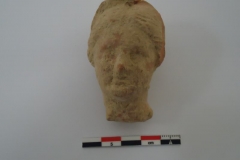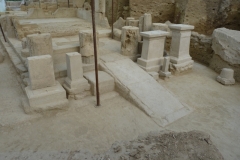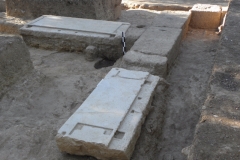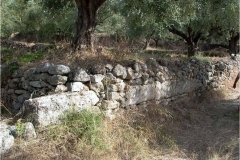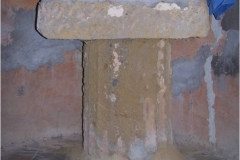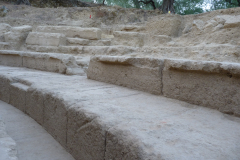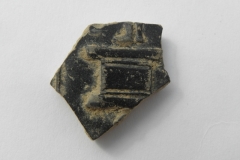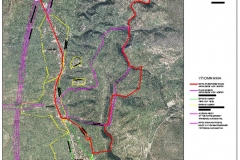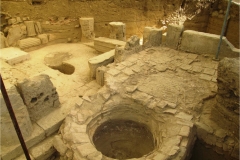During the 2012 excavation season, the Doric temple dedicated to Asclepius and Hygeia was fully uncovered so that the whole monument has now come to light. This was made possible with the partial removal of the built wine press of the early Christian period which covered part of the western side of the ancient temple (FIG.53)
During the partial removal of the wine press, a large number of architectural members were found, which come from the ancient buildings of the sanctuary and had been secondarily used as building material.
The façade of the temple, which was uncovered after the removal of the earth filling that covered the area in front of the monument, is also preserved in excellent state.
The ramp (3,03m long and 1,34m wide) of the entrance to the temple is of extremely careful construction; it is preserved intact and is flanked on each side by impressive statue bases preserved in situ.
Three pedestals are placed to the left of the ramp and two to the right, which are preserved intact and consist of a base, main body and crowning (FIG.54)
The top flat surface of the crowning of both pedestals preserve traces of footprints that belong to bronze statues representing small children, now unfortunately lost. The dedicatory inscription that is inscribed on the façade of one of the pedestals states that two parents named Damofantos and Nikandria dedicated to Asclepius and Hygeia the statues of their two sons, Damothales and Eythymos.
Two smaller almost cubic limestone bases are placed in front of the two pedestals. The first, supports a rectangular pillar, with a dedicatory inscription to Hermes on the façade.
During the excavation in the area, in front of the two pedestals and higher than the layer of the ramp towards the entrance to the temple, a large number of scattered architectural members was found, most of which come from the ionic colonnade of building B’.
More specifically, three parts of fluted columns along with two ionic capitals in good preservation came to light. (FIG.55)
The entire uncovering of the SE corner of the pronaos confirmed the later interventions to the original structure, with the placement of pieces of ionic columns from the stoa (Building B’) in between the spaces of the Doric columns of the temple. (FIG.56)
After the complete uncovering of the plan of the temple, we now know its exact dimensions. The length of the temple is 9,40m in the stereobate and 8,80m in the stylobate. Its width is 6,10m in the stereobate and 5,50m in the stylobate. The total height of the two stepped crepida is 0,46m. (FIG.57)
The length of the pebbled pavement that surrounds the ancient temple is 11,40m on its long sides, 8,10m on its narrow sides and its width is 0,98m.
At a distance of 4,50m south of the temple and parallel to its façade, a grandiose stone altar was uncovered preserved in very good condition. (FIG.58)
The altar is rectangular (dimensions: 3,30m long, 1,15m wide and 1,48m high). It consists of a base, body and crowning, decorated with a cymation. The entire surface of the altar is covered with white plaster, while on the side of the crowning traces of blue and red color can be distinguished that come from the painted decoration that adorned it. It should be noticed that part of one corner of the altar is located under the foundations of the overlying church dedicated to Panayitsa.
At a distance of 0,40m west of the altar, a second smaller cylindrical stone altar was found in situ with an inherent rectangular base (dimensions: 0,57m diameter and 0,62m high), which is also covered with white mortar and with traces of blue color on its surface . (FIG.58)
In front of the large altar, especially along its north-eastern side, a thick layer of ash was found along with burnt soil and with great quantity of broken ceramics and animal bones from the sacrifices that took place in antiquity.
The movable findings from the excavation were mainly ceramics of the Hellenistic period (4th – 2nd c. BC), among which many pieces of relief skyphoi of great quality can be distinguished (FIG.59),, as well as pieces of antefixes with rosettes, two bronze coins (one belongs to Messene and it is dated to the 3rd c. BC), a number of bone ankles and a small glass one (FIG.60). Of great interest is a ceramic black glazed sherd with part of a graffito, on which the letters … ΛΑΠΙ.. are clearly distinguished, the inscription in its complete form was obviously «ΑΣΚΛΑΠΙΩ», thus constituting further evidence on the identity of the temple (FIG.61)


